



To read any of the obituaries of the people listed, click on their name and you will be taken to the particular item.
 |
This linocut was done by Lenore Bassan for the SPAIDS Reflection Area in 2006 |
The following obituary was sent to us by a friend of Hal Bramson - Donald Comras - from the New York Times, 12 December 1994:
"BRAMSON - Hal (Harold), 62, of New York City, of cancer, on December 11, 1994. Survived by sisters Ruth Streitfeld, Esther Solomon, and nieces and nephews and wonderful friends here and in Sydney, Australia. Hal was a volunteer of the Lesbian and Gay Switchboard, the Gay and Lesbian Alliance Against Defamation, the Community Center's Library, was a founding member of ACT UP, and most recently enjoyed working in the kitchen of God's Love We Deliver. Hal requests donations be sent to the Hetrick Martin Institute, 2 Astor Place, NY, NY 10003, so that present and future generations of gay and lesbian youth do not have to go through the self-denial and emotional anguish he and so many of his generation endured."

Lesbian and Gay Solidarity says goodbye to a very special comrade, Simon Nkoli, credited with forming the first black gay movement in South Africa ---- the first organisation to include black lesbians.
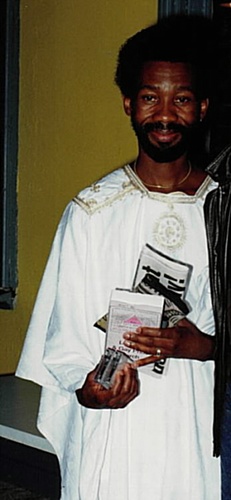
Simon Nkoli addressing a public meeting in Sydney on Friday 10 April 1992
Simon died on the eve of World AIDS Day 1998 from the effects of HIV/AIDS. He was only 41. Simon's funeral was on Saturday, December 12, at Sebokeng, where he grew up ------- a black township serving the steel manufacturing area 50km south of Johannesburg. Writing after the funeral, Steven Cohen said that on the way in to Sebokeng with the "marvellous moffie choir" he felt "white and guilty and grubby in a spoiled kind of way, passing row after row of inhuman hostels. And I thought of the victimisation I had experienced as a queer and a Jew .... and how much it hurt. And I thought of Simon and the way he bore so many crosses, being gay, being black in the old damning South Africa and HIV+ in the new uncaring one.
On the way out", Steven continued, "I felt blameless, included, un-judged. So much more it felt like we all belong together, gay, lesbian and transgendered, HIV+ or not, black and white, camp, butch, young and old. We are Simon"s people, Comrades fighting for our own and each other"s lives."
"Simon Nkoli unified the black and white gay communities. His links with the ANC (African National Congress) after his four years of imprisonment and subsequent acquittal, were hugely instrumental in the entrenchment of gay rights in the new South Africa's constitution."
One can only echo Steven Cohen's feelings which he put into words so succinctly.
My first contact with Simon was in 1986 while he was in prison for treason with 21 other politicals for protesting against rent hikes in South Africa"s black townships in June 1984.
After the trial of the 22 had started in 1987, Simon wrote to tell me that he was the last person to give evidence in Delmas before the trial was moved to Pretoria. He wrote: "I was in the witness stand for seven hours." Prior to his examination, the shortest time for such an examination of one of the accused had been about five days, the longest twenty-two days. Simon was in good spirits, telling me: "I am quite confident that most of us, if not all, will be acquitted at the end of this long trial."
He concluded that particular letter with: "Keep well and wish me good luck. Give my regards to all my gay brothers and sisters over there. I know one day when I am completely free I will travel to Australia." And he did, twice, in 1992 and 1996.
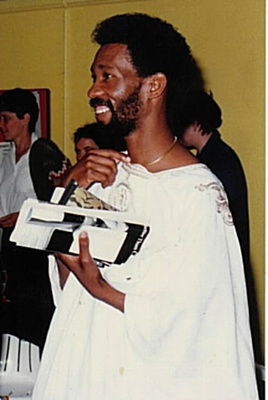
Simon Nkoli addressing a public meeting in Sydney on Friday 10 April 1992
One of his co-accused in the Delmas 22 trial, Terror Lekota, now national chairman of the ANC, remembers him as one of the most enthusiastic, most caring and most intellectually curious of his co-accused. "Over time," says Lekota, "all of us acknowledged that Nkoli's coming out was an important learning experience. His presence made it possible for more information to be discussed, and it broadened our vision, helping us to see that society is composed of so many people whose orientations are not the same, and that one must be able to live with it. And so, when it came to writing the Constitution, how could we say that men and women like Simon, who had put their shoulders to the wheel to end apartheid, how could we say that they should now be discriminated against?" (Mark Gevisser writing in the Sunday Times South Africa, 6 Dec. 1998.)
Towards the end of 1997 when Mannie and I were in Johannesburg we met up with Steven Cohen (mentioned earlier) but missed out meeting Simon again although we were privileged to be shown his personal papers which he had already donated to the gay and lesbian section of the library at the University of the Witwatersrand in Johannesburg.
Of course both Mannie and I had met Simon in Sydney in 1992. We were warned in Johannesburg that it would be hard to catch up with him because one could never be sure where he would be at any given time. He continued to use his time as an AIDS activist to demystify and remove the negative stigma of HIV/AIDS in the African continent.
I feel very sad that I didn"t persevere in Johannesburg in an effort to see this incredible gay man at work in his own country. We shall remember his life when we plant a tree for Simon in the Sydney Park AIDS Memorial Groves ----- Kendall Lovett.

This photo of Walter Hillbrick was probably taken around 1995 when he celebrated his 75th birthday
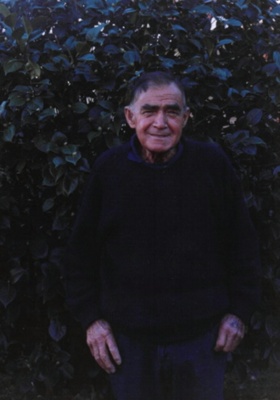
Walter was diagnosed with cancer earlier this year and died on September 11 in Melbourne. Many of us in Sydney knew him because of his association with Melbourne's first organisation for homosexuals, Society Five, in the early 1970s. Walter was one of its founding members. He was either secretary or president of Society Five during the years 1972-1986. Some of the services Walter helped create within the organisation included a telephone advisory support and an excellent library at a time when there were no gay bookshops, no gay press to speak of, and no positive books about homosexuality in most public libraries. When Society Five closed down, Walter continued to run a phone advisory service from his home almost until he died.
Others of us valued Walter Hillbrick for his courage in taking up unpopular causes. He didn't shrink from voicing his anger at injustices, which made him a good front person for a gay organisation, particularly in the hostile 1970s. It certainly didn't start at that time though. According to Gary Jaynes who met him first in 1971, Walter went to prison as a conscientious objector during WWII which led to his co-founding in 1945 of the Prison Reform Council in NSW. Even in his old age his refusal to be quiet about the injustices of age of consent laws put him at odds with conservatives in the gay communities as well as the law.
Even, it seems, in death he wasn't allowed to rest. The day after his funeral, Melbourne Police phoned his home and spoke to a close friend who was there. A city mission health care worker had seen what he considered to be illegal porn on a visit before Walter was hospitalised. This person phoned the police. Walter's friend was outraged and the police undertook to get the person to phone and apologise, which he did.
VALE WALTER.(From Lesbian and Gay Solidarity Newsletter No. 35 - September-October 1997)

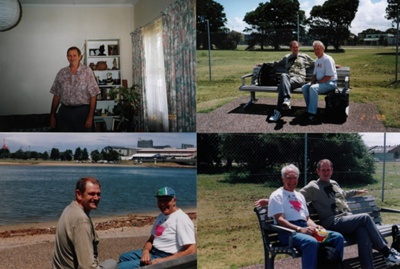
Top left: Gary Stonehouse - at Ken Lovett's house in Newcastle, January 2000; top right and bottom two photos, Gary Stonehouse with Ken Lovett and Mannie De Saxe at Throsby Creek, Newcastle, January 2000
14) OBITUARY: Gary Stonehouse, 17.9.45 – 26.4.04 –a Sydney gay activist of the 70s and 80s, died in Brisbane after a short illness.Gary was a NIDA graduate and a high school teacher. He had been employed for the past 17 years by the PNG Department of Education in the Curriculum Development Division especially as an Expressive Arts officer. His many friends and colleagues in Sydney will be saddened to learn of his death. Gary was one of those involved in perhaps the very first gay rights street protest in Sydney outside St Clements Anglican Church, Mosman, on Sunday morning, 12 November 1972. Gay Lib organised the demo to protest against the sacking of the church secretary, Peter Bonsall-Boone, who had come out and had kissed his lover on the ABC television programme, Chequerboard.
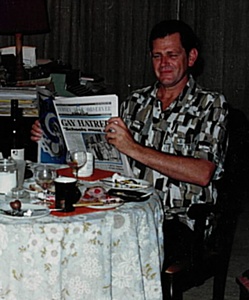
Gary Stonehouse at Ken Lovett's house in Woolloomooloo
An hour or so beforehand I well remember sitting on the floor of my home in Woolloomooloo with Gary and two lesbian friends, Marg and Trish, writing slogans on placards to take with us to the demo. Gary’s placard said “The Belles of Saint Clements!” It was a day to remember. Gary flew back from Port Moresby to be admitted to the Princess Alexandra Hospital in Brisbane. He died three weeks later from cancer, on April 26th. (Obituary by Ken Lovett)

Gary Stonehouse in Newcastle, December 1998
The following is a comprehensive obituary specially written for these pages by Ken Lovett on 27 January 2015:
Informal in style, unconventional, trustingly generous, a self-effacing gay man with a creative flair for the ridiculous, Gary was much-loved by those who knew him well.
In Sydney, he is remembered as an early activist for gay rights as human rights, as a resourceful schoolteacher at Crows Nest Boys High and, as one of the other teachers recalls “a breath of fresh air,” when he arrived to teach at Ashfield Boys High in 1976.
He is also remembered by those he influenced early in his teaching career in Wollongong for much the same reason because of his creative flair for the ridiculous, as well as in Papua New Guinea where he spent much of his later teaching life.
In 1980, Gary was invited to PNG for the South Pacific Festival of the Arts. Later he went back to direct some indigenous productions which eventually led him to accept a teaching position with the PNG Education Department in the mid-80s, and where he remained until his contract expired in March 2004.
There will be lots of gay men and lesbians and many other women activists including some who were close friends, as well as colleagues who would be able to add their own similar recollections of Gary to mine. He was a very funny fellow in so very many respects, a good friend you could lean on for support in a crisis, and at times somewhat of a sad clown much in the way of Charlie Chaplin. He was always ready to stand up and be counted.
I can’t help but remember in 1972, sitting on the floor of my home in Woolloomooloo (inner Sydney) writing slogans with him and two lesbian friends, Marg and Trish, on placards which an hour or so later we would carry outside St Clements Anglican church on a Sunday morning in Mosman. We were there to join a Gay Lib protest at the sacking of the church’s secretary, Peter Bonall-Boone, for coming out as gay on National Television and kissing his same-sex lover Peter de Waal on the ABC’s Checkerboard programme. Gary’s placard said simply “The belles of Saint Clements!”
Another of my recollections around the same time, too, was assisting him at play rehearsals of “The Chinese Wall.” It was a joint production with his Crows Nest Boys high students and those from North Sydney Girls High School. Invariably, at all the schools at which he taught, there would be at least one controversial play performed by his students and chosen, directed and produced by Gary himself.
I went with him also when he had to appear in a Sydney courtroom to answer a charge of indecent behaviour. He was charged by a plain clothes detective, acting as an agent provocateur –an extremely nasty and thoroughly provocative means used by the NSW Vice Squad to intimidate gay men and those perceived to be gay especially during the 70s and 80s. He was devastated. In 1979, after a spate of arrests of gay men, Gary designed and produced a black and white badge for gay rights activists to wear on demonstrations and street marches which pretty much said how he felt: “Police courts are petty sessions.”
Sadly, Gary is greatly missed by Mannie and me and without a doubt by so many other friends and his aunt and her family in Geelong Victoria. He completed his contract and flew from Port Moresby to Brisbane at the end of March and was admitted to the Princess Alexandra Hospital in Woolloongabba. He was diagnosed with spinal cord and liver cancer and died in the hospital on the 27th April 2004. Each year when Gary returned at Christmastime on school holidays, he would appear on the doorstep sometime early in the festive season in Woolloomooloo and later in Newcastle and then when Mannie and I moved to Melbourne, on our doorstop here in Preston
–Kendall Lovett.
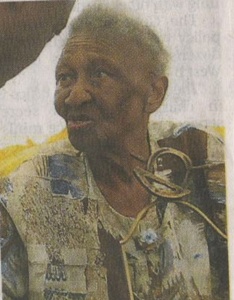
WRITER, CAMPAIGNER AND POLITICIAN
(By SHOLA ADENEKAN in THE GUARDIAN, published in The Age, 25 April 2006)
Ellen Kuzwayo, a solid campaigner against apartheid in South Africa and a tireless fighter for women’s emancipation, who was popularly known as “Ma K,” has died from complications from diabetes. She was 91.
Kuzwayo, a teacher, social worker, community leader and mentor, was elected as an ANC member of South Africa’s first multiracial parliament in 1994, aged 79.
She came from a family with strong ANC ties; as a young woman, she carried her father’s bag at annual conferences. In the 1940s, she joined such leaders as Nelson Mandela, Walter Sisulu and Oliver Tambo in forming the militant ANC Youth League, and served as its secretary. The organization later transformed into Umkhonto we Sizwe (Spear of the Nation), the guerilla faction of the ANC.
NNoseng Ellen Kate Kuzwayo was born into a privileged black family on a farm in the Orange Free State. Her father and maternal grandfather were both active members of the ANC and South African Native National Congress respectively.
As a child, Kuzwayo had not, she said, experienced white oppression. But after her mother died and the farm was seized and allocated to white farmers, she found herself in an uncertain and menacing world. She was educated at St Francis’ College and trained as a teacher at Fort Hare, graduating in 1936 with the highest teacher training qualification available to a black person.
Kuzwayo gave up teaching in 1952 when the Nationalist government introduced the Bantu Education Act, which cut back opportunities for black education. She said she did not have the strength or courage to teach her pupils “what appeared to be very poisonous to their minds.”
Now a mother, she returned to higher education to train as a social worker and shared a bench with fellow student Winnie Mandela. She refused to work with government agencies, collaborating instead with voluntary organizations such as the YWCA, and was at the forefront of a campaign against infant mortality, and promoted cottage industries.
Her first brush with the South African security forces came in 1977, following the 1976 Soweto uprising. The only woman on the committee of 10 set up to organize civic affairs in Soweto, she led the campaign to force the apartheid government to introduce a form of land ownership that would encourage private sector funding into housing in the township. She was detained for five months under the Prevention of Terrorism Act.
Her marital life, too, was turbulent. In her autobiography, Call Me Woman (1885), she recalled years of abuse by her first husband. When she finally fled her marital home, she had to leave her two sons behind. She acted as a shebeen queen, alongside Sidney Poitier, in the film, Cry, the Beloved Country (1951), and later remarried.
Kuzwayo became the first black writer to win South Africa’s leading CAN literary prize. Her second book, Sit Down and Listen (1990), was a collection of short stories in which she took the role of oral storyteller to keep alive the African cultural heritage. The stories highlighted the value of tradition and attitudes, and the plight of women caught between the old and new South Africa. Her film, Tshiamelo – A Place of Goodness, documented her family’s story and the dispossession of their farmland.
In the 1980s, she became the first black woman to receive an honorary degree from the University of the Witwatersrand. She retired as an MP after five years in 1999, when Mandela gave her an Order of Meritorious Service.
Kuzwayo is survived by the sons of her first marriage.

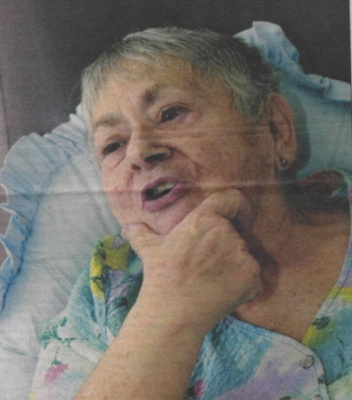
KITTY FISCHER OBITUARY – published in the Sydney Star Observer, 17 May 2001
This is the text of the eulogy written by Cantor Joseph Toltz of Temple Emanuel, Woollahra, Sydney
13 July 1927 – 7 May 2001
Born in 1927 in the town of Puchov, Slovakia, Kitty (Haas) grew up with her parents and her younger sister Eva, and during the first period of World War 2 she was sent into hiding in a convent. Eventually she and Eva were found and deported to Auschwitz.
While hiding in a latrine Kitty met a young academic portrait painter who would save the lives of both her and her sister. This anonymous man had a different symbol on his prison uniform to Kitty – a Pink Triangle rather than a (yellow) Magen David (Star of David). Kitty asked him in fluent German what it meant, and he replied, “Ich bin schwul.” Kitty enquired politely if that was a religion, and he laughed and explained that he was homosexual.
He and his partner had been interred in Auschwitz. He befriended Kitty, and managed to smuggle a hot jacket potato to her every day. This she split with Eva, and it was through this extra nutrition and sheer determination that they survived the horrors of everyday existence in the camp.
After liberation Kitty finished her studies in sociology and emigrated in 1948 to Australia. In 1954 she met Kurt Fischer, and in 1956 her only son Paul was born. Kitty purchased a children’s clothes shop in Kogarah known as Robyn Ann, and ran it successfully by herself until 1964.
In 1965 Kitty embarked on a new project, migrating to New Guinea and staying there until 1972, working as a business advisory officer, developing the native textile industry in the country. The New Guinea government in turn sponsored Kitty for a course in agronomy in Israel and she was there for the outbreak of the Yom Kippur War in 1973, staying until 1975.
She returned to Australia when the news came of the destruction of Darwin by Cyclone Tracey, and she went to work again, this time for the Darwin Reconstruction Committee until its disbandment.
In 1976 Kitty found a new project: a novelty shop in Mount Isa. She worked happily in the shop until 1983-84. She constantly stocked the shop with quirky items (some of a dubiously legal nature at the time), and was often raided by the police as a result, to her delight, as she would always threaten to sue them.
On her return to Sydney, Kitty moved into the Orient Hotel in Kings Cross. It was here that she witnessed first-hand the devastating toll that HIV/AIDS was having on the gay community. Kitty had not forgotten the man who had saved her life so many years ago, and was determined to work for and fight for the rights of gay and lesbian people. She joined Ankali – the organization dedicated to the emotional and psychological support of people living with HIV/AIDS. She publicized her personal story in order to promote human rights.

Photo by Mannie De Saxe on 31 August 1991 of Kitty at a seminar on the origins of the pink triangle, organised by the Gay and Lesbian Holocaust Memorial Project. Kitty, child Holocaust survivor of Auschwitz, talked about her experience and her unexpected encounter with a prisoner with a pink triangle.
Kitty fought for gay and lesbian rights in the wider community as well, involving herself in many of the gay and lesbian Jewish groups that sprang up in the late 90s. She never tired of fighting for reconciliation between the gay and lesbian community and the Jewish community.
The culmination of her fight was the establishment of the Gay (and Lesbian) Holocaust Memorial Project launched in her presence by Justice Marcus Einfeld only a few months ago. It stands in green Park, a symbol for the many gay and lesbian people who have died because of prejudice. Justice Einfeld at the time remarked on the proximity of the Memorial and the Sydney Jewish Museum, and made the point that neither memorial diminished the other – rather they both enforced the idea of eternal vigilance against prejudice and bigotry in the community. Kitty was very pleased.
Three years ago Kitty lapsed into a sudden, mysterious coma, and she battled for three years to regain her health. She eventually moved to Charingfield Catholic Home, where she was welcomed as an exceptional case. She was treated with great respect by the staff and residents, many of whom were retired priests and nuns. Kitty still worked for reconciliation – this time between Jews and Christians in the home where she lived.
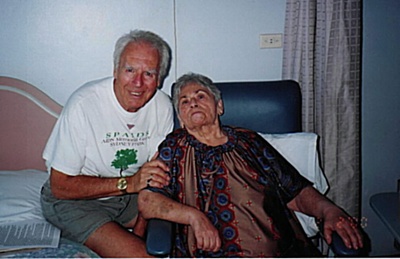
This photo of Kitty and Mannie was taken at Charingfield in 2000, the year before she died.
Kitty was involved in Shoah (Holocaust) Project video testimony. She was also the subject of a sociology doctorate into migrant women. Kitty was very involved in the B’nai Brith Albert Einstein unit for many years, working against discrimination. She is survived by her son Paul, and her nieces and nephew Helen, Naomi and Sam. Sydney has lost a special and feisty individual.
Sasha Soldatow: born 7 December 1947, died 30 August 2006 aged 58
The biographical notes which follow are at the beginning of "Jump Cuts", the "Autobiography" Sasha wrote with Christos Tsiolkas, published by Vintage in 1996:
Born in Germany of Russian parents, Sasha Soldatow came to Australia in 1949 as a displaced person. He studied music and history at Melbourne University, leaving Melbourne to live in Sydney in 1972. There he hit the Push and became involved with talking, arguing, drinking, demonstrating, squatting, sex, gay liberation, feminism, the abolition of all prisons, anarchism, performance, the problem of truth and taking off his clothes in public. He worked in the translation section of SBS for nine years and has published five books ( by 1996). The most important things in his life are friends, idealism and a love of anything new. He misses Hanoi, Naples and Leningrad, and has recently started painting again.
By 1996 Sasha had published:
Politics of the OlympicsIn 1996 Vintage published JUMP CUTS An Autobiography, Sasha Soldatow and Christos Tsiolkas
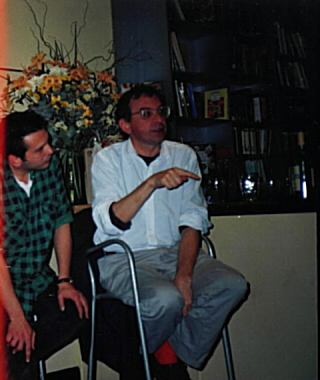
Christos Tsiolkas and Sasha Soldatow launch their book "Jump Cuts" at Pepperina's Book Shop in Newcastle, 12 July 1996

The following obituary of Sasha was written by David Marr and published in the Sydney Morning Herald on 9 September 2006:
SASHA loved a crisis. Friends rallied. He was the centre of attention again. Whatever the scrape - betrayal, eviction, injury, neglect or poverty - someone always came to his rescue. But the latest crisis got a little out of hand and Sasha hasn't been around to enjoy the fuss.
After years of drinking, this impish writer and troublemaker died of liver failure at St Vincent's Hospital early on the morning of August 30. As he drifted towards death, old friends and lovers hung about in the corridors trying to piece together the story of his life. It wasn't easy. Each of us knew only fragments.
Alexander (Sasha) Pavlovich Soldatow was born near Stuttgart to Russian parents washed up in Germany after the war. The boy was two when they reached Melbourne in 1949. Raised by a suffocating troika of mother and aunts, he was playing the piano in the Box Hill Town Hall at six.
The piano became another of the many things Sasha could do but rarely did, like making love to women or holding down a job. When he fled Melbourne and his family for the freedom of Sydney in the early 1970s, he announced he was a writer and plunged into the politics of the Push, the only gay man in that hard-drinking hetero crowd of radicals. He played a brave part in the stoushes of those years with rotten cops and corrupt developers.
To fall in with Sasha at this time was a life-shaking experience. He marched and drank under the banner of Liberty. Behind him he trailed the notion that he was a spirit from another place - that his ideals, his taste, his thirst and his often-gloomy soul were essentially Russian. He had things to teach and he was not to be contradicted. The deal he offered was this: place yourself in my hands, and I will set you free.
Meanwhile, he was a dab hand at finding people to look after him. He lived in Margaret Fink's fine Woollahra mansion for years. She said this week: "He handled poverty rather well, until the end." He did it all on nothing in those early years - good lunches, good travel, good company and endless time for writing. Back then it was poetry, stories and gossip for pamphlets and a little magazine he roneoed himself called The Only Sensible News. Sasha was a highly principled gossip. He would insist: "It has to be true."
His other career - for which there remains a discriminating fan base - was as Russian subtitler at SBS where he immersed himself for most of the 1980s in flagon red and the great classic films of Soviet cinema. When SBS tried to sack him - he always claimed it was for gossiping - the union had him reinstated. Thereafter, he didn't bother to turn up to work. He argued: "They can't get rid of me now." But they did.
He craved literary recognition but he was nearly 40 before Penguin published a volume of short stories and portraits called Private - Do Not Open. "Soldatow is one to watch," was this paper's verdict. "He writes like no one else in Australia at the moment." But he spent the next few years slaving over an edition of the work of Fink's old flame, the poet Harry Hooton. This appeared in 1990 but was never destined to sell.
Frustrated by this failure to make his mark, he sued the Australia Council, claiming he represented "all those authors who have been set outside the cabal of chosen writers which distributes the taxpayers' money each year". He liked the notoriety and fuss, but his efforts yielded little. He was given a few residencies here and there, including three months as "writer in residence" at Sydney's Long Bay jail. He told the press he trusted murderers: "You don't have to have 15,000 dinners with them. You get straight to the heart of the matter quickly."The heart of the matter for Sasha was always Russia and in 1991 he embarked on the great adventure - and perhaps the great disaster - of his life. His attempt to live as a Russian in Moscow failed after a few months and he retreated to the luxury of Monica Attard's ABC apartment.
Long smoky nights with drunken intellectuals followed. Then in midwinter he slipped on the ice, shattered his leg and after grim weeks in a Soviet hospital was shipped to Australia an invalid.
This was the beginning of the long slide - he was now addicted to Valium and drinking heavily - but the next few years were his best as a writer. After Mayakovsky in Bondi appeared in 1993, he was midwife to Christos Tsiolkas's fine first novel Loaded, which enjoyed the instant celebrity that evaded Sasha all his life. His last book was an odd mutual biography the two men wrote together called Jump Cuts.
Old friends were dropping away. There were still flashes of the carefree naughty boy, the dangerous charmer of his heyday, but Sasha was becoming hard work even for the most loyal. After a doomed attempt to live in the bush, he retreated to Melbourne where he ended up in a room at Percy's hotel in Carlton above a bar where intellectual conversation of a kind was available night and day.
Friends rallied and brought him back to Sydney. For a year or so he lived in Cremorne, talking a lot but writing nothing, turning into a little old babushka. He still loved a good lunch.His last stop was a housing commission flat in Waterloo where Bruce Pulsford, the guardian angel of his last 20 years, found Sasha collapsed and took him after the usual arguments to St Vincent's. He died five days later.
Sasha Soldatow is survived by countless people whose lives he changed; by great jokes and unforgettable conversations; by books published and unpublished; by the carefully catalogued memorabilia now in the Mitchell Library; by his mother and step-siblings. He asked for a literary prize to be established in his memory to honour writers who haven't had the recognition they deserve. His last publication will be the words he ordered for his tombstone: I See.
David Marr
The Australian newspaper published the following obituary of Sasha by Bruce Sims and George Papaellinas on 15 September 2006:
Sasha Soldatow
GEORGE: To try to summarise, even Sasha's liaisons would involve more words than we're allowed. A list of his lovers would be long indeed and litigious in itself (not something that Sash would ever have shied away from), so trying to summarise his entire life is not too easy.
Bruce: Sasha seemed to be everywhere and to know everybody. A child of World War II, he was born in Germany in 1947 of Russian refugee parents. His interests make him a child of his heroic Russian Revolution and an older Russia that he heard all about from his beloved grandmother. His more obvious commitments were to letters and politics, but his Russian-ness was elemental. His Melbourne University friends grew used to being dragged along to interminable Russian Easters, not because of any interest in the church -- Sash was a committed atheist -- but because he was also a committed Russian.
G: Sasha recognised that a life in a turbulent 20th and 21st centuries, full of migration, demands a dual identity. He visited his spiritual homeland, Russia, but suffered no confusion. "I'm not a Russian," he declared to Russians who wanted him to stay, "I'm an Australian!" I got to know the Sasha who moved to Sydney at 24 where he obviously felt he could better be himself; gay, political and very social. His lifelong mantra was that the personal is political, so he was just being himself when he embroiled himself in such public disputes as the fight against property development in Victoria Street in Kings Cross in particular. He was a tireless fighter in the resistance to all reactionary social practices, including what he saw as the cruel and barbaric regime of imprisonment. To Sash, his politics and his art, writing and music were indivisible. He typifies the Russian new revolutionary man of the future. His heroes included his grandmother; his dear father, an Olympic medal-winning athletic champion; the hard-drinking revolutionary Russian poet, naughty Vladimir Mayakovsky whom Sash energetically modelled himself on, as well as on the dissident, anarchistic Australian poet, Harry Hooton, whose work he collected in book form.
B: He was also a forerunner in the gay liberation movement, often in unexpected ways. His cabaret performances were steeped in libertarianism, cheek and political incorrectness. When the rest of fashionably leftist Sydney was busy discovering itself, Sash turned up at one party with a copy of their latest, very serious hero Althusser's book on a leash like some sort of pet puppy.
He did a lot of voluntary work, some of it in prisons, and worked as a sub-titler for SBS, sometimes coming to work with a bottle of vodka. But mostly he survived on little money, enraged into legal action against the Australia Council questioning its grant procedures. He was successful, and eventually got a grant.
G: I'll never forget our long, rambling, chatty walks together along Bondi Beach, punctuated by frequent swoops on Russian cake-shops, tea and coffee houses. The Russian community congregated there and Sash lived there too for many years in connubial bliss with his dear Bruce Pulsford.
B: Perhaps neither of them would use those words, but it was certainly Sasha's most enduring and strongest relationship. Their flat in Bondi was a centre for dinner parties, memorable occasions and long conversations.
Sasha produced a lot of ephemeral pamphlets and poetry, almost as fleeting as his collections of postcards and tickets. His substantial creative work, Private -- Do Not Open was one of the first explicitly gay works published by a mainstream Australian publisher. Mayakovsky in Bondi followed with its memorable opening sentence: "I am trying to remember what my father's cock looked like." He also co-wrote the fascinating autobiographical work, Jump Cuts with Christos Tsiolkas.
G: His service to others as sounding board, editor and moral compass was his major achievement. As well as offering concrete and steady support, he could be infuriatingly contradictory and difficult, too, sometimes. That's why most of his friends stuck by him, I imagine.
B: He returned affection by constantly giving advice and sometimes bizarre gifts, good cooking and gardening tips, but friendship above all, his greatest talent. He was occasionally combative but always warm and humane. He could never pass a beggar in the street without sharing his money and cigarettes. That was a matter of principle. In Russia, Sasha slipped on ice and fell while farewelling a late-night guest. The repair was botched by Russian doctors and his bad leg plagued him for the rest of his life. The toll exacted by lots of drink and pills didn't help his health. He was completing a translation of the poetry of Ahkmatova when he died, as well as continuing with work on his own writing and painting.
G: "Don't just be ordinary, be extraordinary," he demanded of those around him. Always! "And always demand honesty from people! The truth is everything."
Pam Brown's Blog - Remembering Sasha
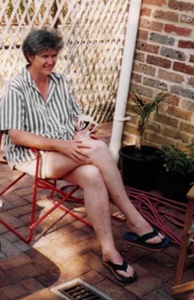
The following obituary appeared in Lesbian and Gay Solidarity Newsletter Number 56, July-November 2003
VALE HELEN WHITECHURCH - LONG-TIME LESBIAN ACTIVIST:
We were shocked when late in August (2003) news reached us that one of the women who had been active in lesbian and gay politics since the seventies had died suddenly and unexpectedly in Sydney. Helen Whitechurch was a fulltime worker in education and held a Masters Degree in Educational Administration. We shall miss her quiet, reserved friendship and, conversely, her strong, open support for equality and human rights and her opposition to the war in Iraq.

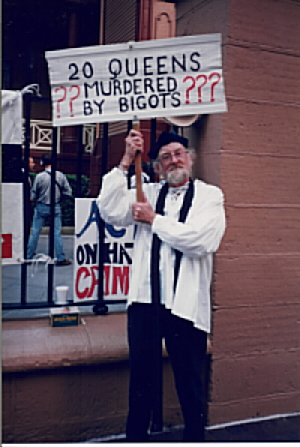
The following obituary of John Foxall by Ken Lovett appeared in LGS Newsletter No.65
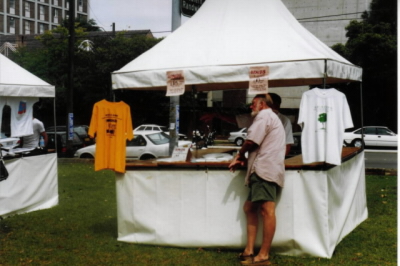
John Foxall visiting the ACON Hunter stall at Mardi Gras Fair Day, Victoria park, Sydney, 1998 (photo: MannieDe Saxe)

Peter McGregor died in Sydney on 11 January 2008. He was just 60 years old.
Peter was an activist from before the 1970s and in 1971 was one of those, with Meredith Burgmann. who actively attempted to disrupt the Springbok rugby tour of Australia.
Peter was in Melbourne only a few weeks ago to go to Ballarat to receive a Eureka award for his attempted citizen's arrest of Philip Ruddock at the University of New South Wales, and his attempted citizen's arrest of John Howard, Philip Ruddock and Alexander Downer at Parliament House in Canberra during 2007.
In his 40 years of activism Peter was always, as an Anarcho groupie, a friend of gays and lesbians, working with them to achieve equality and end discrimination.
In fact, Peter was a friend of activists of all sorts and political persuasions, and he had an enormous circle of friends.
One of Peter's regular activities was to visit the SPAIDS Groves on tree-planting days whenever he could get to Sydney from Newcastle. He also brought friends with him on regular occasions, and amongst the friends were John and Margaret Brink, two anti-apartheid South African activists who had had to leave South Africa in the 1960s for political reasons. Peter became very friendly with them and they influenced him in his anti-apartheid activism for many years.
Peter and his partner Jo have lived in Newcastle for many years, and he leaves his partner Jo, family and many, many friends around Australia and overseas who will remember him with great warmth and sorrow at his early death.
This message has been posted by Ken Lovett and Mannie De Saxe, Lesbian and Gay Solidarity, Melbourne, and long time friends of Peter's and Jo's.
For a comprehensive picture of Peter McGregor, see our web page: Peter McGregor - A Memoir

Died on Wednesday, August 27, 2008 at UCSF Hospice, San Francisco, California. Survived by spousePhyllis Lyon, daughter Kendra Mon, son-in-law Eugene Lane, granddaughter Lorraine Mon, grandson KevinMon, sister-in-law Patricia Lyon and a vast, loving and grateful lesbian, gay, bisexual and transgender family.
An eloquent organizer for civil rights, civil liberties, and human dignity, Del Martin created and helped shapethe modern lesbian, gay, bisexual, transgender (LGBT) and feminist movements. She was a woman ofextraordinary courage, persistence, intelligence, humor, and fundamental decency, who refused to besilenced by fear and never stopped fighting for equality. Her last public political act, on June 16, 2008, wasto marry Phyllis Lyon, her partner of 55 years. They were the first couple to wed in San Francisco after theCalifornia Supreme Court recognized that marriage for same-sex couples is a fundamental right in a casebrought by plaintiffs including Martin and Lyon.
Born in San Francisco on May 5, 1921, Dorothy L. Taliaferro, or Del as she would come to be known, wassalutatorian of the first graduating class of George Washington High School and went on to study journalismat the University of California at Berkeley. At 19, after transferring to San Francisco State College (now SanFrancisco State University), she married James Martin and two years later gave birth to their daughterKendra. The marriage ended in divorce.
Del Martin met the love of her life, Phyllis Lyon, in Seattle in 1950 when they worked for the samepublication company. They became lovers in 1952 and formalized their partnership on Valentine's Day in1953 when they moved in together in San Francisco. In 1955, they bought the small home that has beentheirs ever since.
In what would prove to be an act that would change history, Martin, Lyon, and six other lesbians co-foundedthe Daughters of Bilitis (DOB) in San Francisco in 1955. DOB, which was named after an obscure book oflesbian love poetry, initially was organized to provide secret mutual support and social activities. It becamethe first public and political lesbian rights organization in the United States, laying a foundation for thewomen's and lesbian and gay liberation movements that flowered in the early 1970s and continue today.
Del Martin used her writing and speaking talents to challenge misconceptions about gender and sexuality.
"We were fighting the church, the couch, and the courts," she often remembered years later, naming thearray of social and cultural forces early activists confronted when homosexuals were treated as immoral,mentally ill, and illegal. As the first President of DOB, she penned stirring calls to arms.
"Nothing was everaccomplished by hiding in a dark corner. Why not discard the hermitage for the heritage that awaits anyred-blooded American woman who dares to claim it?"
She was the second editor (after Phyllis Lyon) ofDOB's groundbreaking monthly magazine, The Ladder, from 1960 to 1962 and ushered in a new decade of political engagement and media visibility for the nascent gay rights movement.
The Ladder grew from a mimeographed newsletter in 1956 to an internationally recognized magazine with thousands of subscribersby 1970, and thousands more readers who copied its contents or circulated it among friends and coworkers.Martin's many contributions to The Ladder ranged from short stories to editorials to missives: one of the most famous is "If That's All There Is," a searing condemnation of sexism in the gay rights movement writtenin 1970.
Due to Martin's influence, The Ladder provided one of the few media outlets confronting misogyny in the decade before the rebirth of women's liberation.
In 1964, Del Martin was part of a group that founded the Council on Religion and the Homosexual in order tolobby city lawmakers more effectively to reduce police harassment and modify the sex laws thatcriminalized homosexual behavior. In later years, Martin was also a founding member of the LesbianMother's Union, the San Francisco Women's Centers, and the Bay Area Women's Coalition, among otherorganizations.
As an early member of the National Organization for Women (NOW), Del Martin worked to counterhomophobia within the women's movement " fear of the so-called 'lavender menace.'" She and Lyon werethe first lesbians to insist on joining with a "couples" membership rate, and Martin was the first out lesbianon NOW's Board of Directors. Their efforts helped to insure the inclusion of lesbian rights on NOW's agendain the early 1970's.
Lesbian/Woman, the book they co-authored in 1972, is one of Martin and Lyon's landmark accomplishments. The book described lesbian lives in a positive, knowledgeable way almost unknown at the time. In 1992,Publishers Weekly chose it as one of the 20 most influential women's books of the last 20 years.
For many years, Del Martin was a leader in the campaign to persuade the American Psychiatric Associationto declare that homosexuality was not a mental illness. This goal was finally achieved in 1973.
Del Martin's publication of Battered Wives in 1976 was a major catalyst for the movement against domestic violence. Martin became a nationally known advocate for battered women, and was a co-founder of the Coalition for Justice for Battered Women (1975), La Casa de las Madres (a shelter for battered women)founded in 1976, and the California Coalition against Domestic Violence (1977).
She lectured at colleges anduniversities around the country. Martin received her doctorate from the Institute for Advanced Study ofHuman Sexuality in 1987.
Martin's keen political instincts and interests extended her influence into the mainstream Democratic Party.She and Lyon were co-founders, in 1972, of the Alice B. Toklas Democratic Club, the first gay political club inthe United States.
Martin was appointed Chair of the San Francisco Commission on the Status of Women in1976 and served on the committee until 1979. She worked as a member of many other councils and boardsincluding the San Francisco Commission on the Status of Women. Throughout the years, many politiciansrecognized their stature as community leaders and sought advice and endorsement from Martin and Lyon.
It is difficult to separate Del Martin and Phyllis Lyon and write about only one of them. Their lives and theirwork have intertwined and their enduring dedication to social justice has been recognized many times. In1979, local health care providers established a clinic to give lesbians in the San Francisco Bay area access tononjudgmental, affordable health care and named it Lyon-Martin Health Services in their honor. In 1990, theAmerican Civil Liberties Union (ACLU) of Northern California awarded the couple with its highest honor, theEarl Warren Civil Liberties Award.
In 1995, Senator Dianne Feinstein named Martin, and CongresswomanNancy Pelosi named Lyon, as delegates to the White House Conference on Aging, where they madeheadlines by using their moment at the podium to remind the 125,000 attendees that lesbian, gay, bisexual,and transgender people grow old, too, and must be included explicitly in aging policies.
The Society for theScientific Study of Sexuality gave Martin and Lyon their Outstanding Public Service Award in 1996. They areamong the most beloved figures in the LGBT community and have served as Grand Marshals at Pridemarches across the nation and been honored by every major LGBT organization in the country.
Del Martin identified her own legacy in 1984 when she said that her most important contribution was "beingable to help make changes in the way lesbians and gay men view themselves and how the larger societyviews lesbians and gay men." She had the courage to be true to herself when the world offered onlycondemnation for lesbians. Martin showed all of us how to have what she called "self-acceptance and agood sense of my own self-worth."
Del Martin never backed down from her insistence on full equality for allpeople and, even at 87 years old, she kept moving all of us closer to her ideal.
Gifts in lieu of flowers can be made to honor Del's life and commitment and to defeat the Californiamarriage ban through NCLR's No On 8 PAC at www.nclrights.org/NoOn8.
A public memorial and tribute celebrating the life of Del Martin will be planned in the next several weeks.
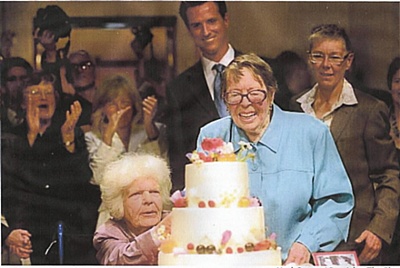

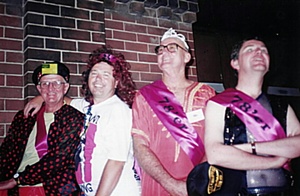
Lance Gowland, being one of the 78ers, was amongst other 78ers at the end of the Mardi gras parade in 1998, which celebrated 20 years of gay and lesbian mardi gras and parties after the parade. This photo was taken by either Ken or Mannie.
The following obituary is reproduced here with the kind permission of Peter Murphy:
Lance Gowland, a rebel against discrimination and injustice, changed the face of Sydney. He died peacefully on Labour Day in Sydney, October 6, 2008, surrounded by his children and friends, after years of fighting prostate cancer.
Police violently hauled Lance from the driver’s seat of the sound truck in the now-famous 1978 Mardi Gras demonstration, but he was rescued by a mass of the revellers that night. His treatment by police, and the early shut down of that first parade, sparked the riot at Kings Cross that cemented the parade’s place in the city’s modern history.
Gowland had pushed for the night street carnival to be added to the International Gay Freedom Day (Stonewall) events in Sydney in 1978, knowing it would attract many people and move beyond the political demonstrations and lobbying that had been the main focus of those pushing for gay law reforms.
Gowland played a key role in organising the second Mardi Gras parade in 1979, and remained involved until 1984, the year homosexuality was decriminalised in NSW.
A committed unionist, peace activist and Communist Party member, he played a significant role in convincing those on the political left and trade unions to support gay and lesbian rights in the early 1970s. He was at the forefront of Australia’s first public demonstration for gay liberation, along with Denis Freney, in Martin Place in 1971.
Lancelot Joseph Gowland, who was 72, was the second son of George, a shearer and jack of all trades, and Winifred. His parents were both communists. One of his aunts, Peace Gowland was married to Wally Clayton, the famous Mr X of the Petrov Royal Commission, and so Lance knew well the ferocity of the ‘cold war’.
Young Lance became involved in the Eureka Youth League and the anti-apartheid and peace movements while still at Westmead High School.
After finishing school, he travelled to Europe, the United States and Israel, and was involved with the British Communist Party and peace movement. He witnessed another defining moment in civil rights - Martin Luther King delivering his “I have a dream” speech on the steps of the Lincoln Memorial in Washington in 1963.
Returning to Australia, he worked on the Snowy Mountains Scheme, where he met his future wife, Norma Judd. He joined the NSW Public Service and they raised three children in Goulburn, where he was secretary of the Goulburn Trades and Labor Council and the Progress Association. When the big split over the Soviet invasion of Czechoslovakia took palce in the CPA, it tore his extended family apart. Lance remained very active in the CPA and then the SEARCH Foundation after 1991.
As the gay rights movement grew, so too did Lance’s realisation that he was gay. He separated from Norma and ‘came out’, leaving Goulburn for a job in the Quarantine Service in Sydney but retaining strong connections with his children and, later, grandchildren.
Lance volunteered for the telephone counselling service run by CAMP (Campaign Against Moral Persecution) NSW, Sydney’s first gay rights organisation. He became a key figure in CAMP, Gay Liberation and later the Socialist Lesbians and Male Homosexuals. He was on the organising committees for the national homosexual conferences from the mid-’70s.
On his retirement, he used his superannuation to buy a yacht, Eureka, and fulfilled a childhood dream to sail the Pacific. At age 70, he sailed his yacht to Nauru in 2004 as part of the Flotillas of Hope to Nauru to protest against the Howard government’s policy of detaining asylum seekers.
The Flotilla was met outside Nauru harbour on World Refugee Day, June 20, by six patrol boats loaded with uniformed men, and the harbour master screaming over the VHF radio for the yachts to go to the 12 nautical mile exclusion zone or face arrest. The sailors tried to negotiate a way to get some gifts to the refugees, but were escorted to the 24-mile zone.
“Our crime was to carry gifts to the asylum seekers held in detention in Nauru,” Gowland recalled. “Our fight … was with the Australian government for trying to hide its illegal treatment of refugees in the desert at Baxter or in the Pacific like Nauru. That was our real crime, we were drawing the world’s attention to the ‘Pacific Solution’.”
Lance Gowland is survived by Norma, their children Christopher, Geoffrey and Vanessa, grandchildren Alisa, Caradoc, Oscar, Arada, Mabel and Benjamin. Our sincere condolences.
John Witte, Ruth Pollard and Peter Murphyfrom the Sydney Morning Herald, Oct 21, 2008.Extract from Pride History Group obituary for Lance Gowland. Another part is the above obituary also on the Pride History Group web site.
Memory of Lance at the first Mardi Gras from Jo Harrison, Adelaide
I was 19, was running late as usual, and had only made it to the corner of Hyde Park as the mardi gras was just about to arrive having come down Oxford St standing on the median strip the truck turned in front of me into College St saw the cops fighting with the driver, saw the whole drama unfold in front of me. Didn't know who Lance was at that stage but thought 'wow what a brave guy he must be'.
Then my sister danced up dressed as Carmen Miranda, and the 'on to the cross' shouting began. Oh good thought I, I haven't missed the fun after all....................
Vale Lance.

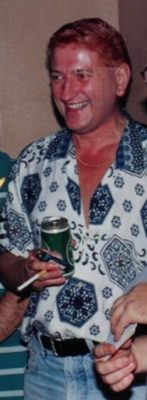

This tribute to Miriam Makeba was in a Nigerian online newspaper and is reproduced in full:
On stage, Miriam Zenzi Makeba exuded an uncommon grace that was unforced just like the simple lyrics of her songs that has thrilled audiences across the world for decades. You need not understand the lyrics of her songs to appreciate both the intensity of their message, or the ingenuity that underpin them. They were simple country ballads and village lores that evoke memories of lost innocence, an idyllic existence that speaks to our shocking repudiation of brotherhood and community.

Yet, those innocent lyrics, devoid of any fiery rebuke, were considered atrocious by South Africa’s then apartheid government which revoked her citizenship and right to return to her home country, after her appearance in a riveting anti-apartheid documentary, Come Back Africa, in 1960.
Thus began a spell in exile that spanned decades from the United States (from where she fled after series of harassment from the authorities) and later Guinea. The Guinean government of Sekou Toure gave her all the courtesies a continent’s mother (she is popularly called Mama Africa) deserves, even asking her to address the United Nations General Assembly on its behalf. She did that twice, and on each occasion spoke out against the evils of apartheid.
More accolades were to come later: She was received by such world leaders as Hailé Selassie, Fidel Castro, John F. Kennedy and François Mitterrand. Makeba has also toured with great singers such as Paul Simon, Nina Simone, Hugh Masekela and Dizzy Gillepsie.
A website created to honour accomplished South African nationals (zar.co.za) notes: “The ban on her records was lifted in South Africa in 1988 and she returned to her homeland in December 1990. Four years later, she started a charity project to raise funds to protect women in South Africa. Her first concert in South Africa (1991) was a huge success and this was a prelude to a world-wide tour which included the USA and Europe.”
She was married to Stokely Carmichael, a radical Black Panther leader. She had also been married to Hugh Masekela.
Although well received on the American culture scene, the love turned sour after her marriage to Carmichael, in 1968. The US never placed a formal ban, but her once thriving concert deals suddenly dried up. It is remarkable that she lived through the trauma without a whiff of bitterness in her songs and comments.
Where the evil wrought by apartheid made life seem hopeless for her fellow black South Africans, her music offered a soothing relief and gave them reasons to smile and cling onto life. The test of true art is in its ability to stay evergreen. Makeba’s music has remained appealing decades after, surviving the onslaught of disco, hip-hop and the sub-cultures they have inspired in Africa.
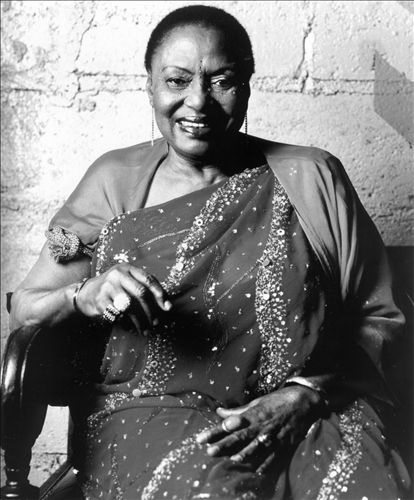
Since her death was announced, there has been an endless stream of eulogies. It’s no surprise given the accomplishments of this simple but exceptional woman whose music was – and still remains – a signature tune for all Africans.
Born 1932 in Johannesburg, South Africa, Makeba’s first shot to limelight was as a vocalist with the Manhattan Brothers in 1954. She would later quit to record with her all-woman group the Skylarks while touring Southern Africa with Alf Herberts' African Jazz and Variety, an 18-month tour reputed to have launched the careers of many African artistes.
But it was a talent that blossomed much earlier when as a 13-year-old, she was adjudged winner of a talent show at a missionary school. The town took note; often inviting young Makeba to sing at weddings and other social functions.
In 1959, Makeba starred as female lead in the show, King Kong, a Broadway-inspired South African musical. She would later sing at President John Kennedy's birthday, working in New York with Harry Belafonte where tunes such as "The Click Song" and "Pata Pata" were created.
Performances in Europe and America brought her to the attention of Harry Belafonte and Steve Allen which helped catapult her to fame. In 1959, she won a Grammy award for the album An Evening with Harry Belafonte & Miriam Makeba.
Her other awards include, the 1986 Dag Hammerskjold Peace Prize and the UNESCO Grand Prix du Conseil International de la Musique.
In 1967, one of her most popular tune, Pata Pata, was released in the United States and scored an instant hit worldwide. Other popular and commercially successful songs include Welela, Malaika and several memorable tunes that were just the perfect anthems for a black world in the turbulent ’60s seeking for a voice capable of giving meaning to the expression, black is beautiful.
Makeba surmounted challenges including the effects of several car accidents, a plane crash and even cancer. But there is always a time to take the final bow and exit the stage. Makeba has just succumbed to that eternal rule. The ovation remains as it was when she first walked into our lives – and stole our hearts.

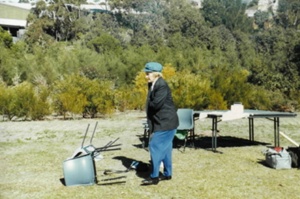
Marie Fisher at the 10th SPAIDS planting 24 August 1997
SO LONGWe were saddened to learn of the death of Marie Fisher on November 16 (SSO 945). Marie was a longtime supporter of SPAIDS Memorial Groves and had attended the AIDS tree plantings from the very first ones in 1994.
She also represented various lesbian, gay and transgender groups at ADB Consultations and was a friendly presence at so many community events.
We shall miss seeing you, Marie, at the 2009 AIDS planting. We shall plant a tree especially for you.
— Mannie and Ken, Sydney Park AIDS Memorial Groves.
This obituary comes from an organisation which was close to Irene's heart and with whom she was deeply involved. As one of those who hosts these web pages - I (Mannie De Saxe) am a cousin of Irene's partner Richard Kuper, and although we didn't ever meet, it is quite obvious that Irene's politics and mine have been fairly similar over many years. She died far too young, the second member of my family in a period of months at the end of 2008. Our sympathies to Richard and their families.
Independent Jewish VoicesWe are sad to have to announce the death of Irene Bruegel, who started Jewsfor Justice for Palestinians. Irene was 62 and has disappeared long before her time and will be greatly missed. Below is an appreciation put out by Jews for Justice for Palestinians followed by some tributes from IJV members.
Irene's energy, commitment and creativity and that of her partner RichardKuper, were central to the establishment and spectacular growth of JfJfP.She returned from a trip to the West Bank at the end of 2001, determined todo something, and when she was determined, something usually got done. Froma meeting of fifteen of Irene and Richard's friends in a pub near KingsCross, JfJfP has grown into one of the biggest and most influential Jewishorganisations campaigning for the end of the Israeli occupation of thePalestinian territories and the negotiation of a just and peacefulsettlement in Israel/Palestine. Irene was brimful of ideas about extendingJfJfP's work. She avoided sloganizing, ever aware of the importance ofreaching people who might join in a campaign for justice, if they were onlyprompted in a constructive way. She was usually the one who picked up thepieces if one of us dropped them.
For several years Irene also chaired JfJfP's charitable offshoot - theBritish Shalom Salaam Trust. Her loyalty, determination and tenacity ensuredthat BSST became a hugely important lifeline for dozens of grassrootseducation, health, peace and cultural projects on both sides of the GreenLine.
In this year, the sixtieth anniversary of Israel's foundation, Irene had twopriorities - that the sixtieth anniversary of the Palestinian Nakba beremembered, and that we celebrate the courage of all those Israelis whoselives are committed to combating the occupation. The 'Another Israel'exhibition, which she organized, oversaw, and which continues to bedispatched all over Britain, is a memorial to her imagination andenthusiasm.
Irene was many things - a feminist, an internationalist, a writer and ateacher. Above all, she was an activist, who thought the point of heracademic writing and her other work was to effect progressive change. Wehope to establish a fund to commemorate her work and will let you know assoon as this has this has been agreed.
Our thoughts are with Richard and the children, Martin, David, Dan & Jo andthe other members of her family.
Tributes from members of the original IJV Steering GroupIrene was simply indefatigable. I have watched her over the years createwith such determination and conviction the political space she so stronglyfelt was needed for Jews on behalf of Palestinians. It was immensely boldand it worked, through her and through Richard. IJV learnt from her. Wehave always known how much we are in her debt.
Professor Jacqueline RoseThe death of Irene Bruegel leaves the world a poorer place, bereft of one of the most vital and passionate people ever to have taken up the cause of justice for Palestinians in Britain. It was the ‘modest proposal’ Irene sent out to her Jewish friends in 2001, suggesting that we could, and should, raise our voices collectively to express our dismay at the ongoing annihilation of the human rights of Palestinians in Israel’s Occupied Territory that became the trigger for so many us to begin working for peace and justice in that region. Together with her partner, Richard Kuper, Irene was in every sense uniquely inspirational in making contacts around the world for encouraging Jews and Palestinians to work together for peace. I have always been inspired and moved by Irene’s courage and imagination, and am confident that her memory will continue to encourage us to support those causes that she fought for so tenaciously. However, her energy, creativity, insight and intelligence will be sorely missed as Irene was, quite simply, an irreplaceable presence in our midst.
Professor Lynne SegalWhen Irene Bruegel started Jews for Justice for Palestinians it was animmensely brave and imaginative venture. In typically uncompromisingfashion Irene insisted on putting the word ³Palestinian² in the name,knowing that it would cause ripples in the Jewish community but Justice forPalestinians WAS the issue and there was no compromising with that. Withunflagging energy, even in the face of illness, Irene pursued that end in avariety of ways, not least the setting up of the splendid Shalom/SalaamTrust, adding practical assistance to the activities of a pressure group.
Ann JungmanIndefatigable is the word that comes to mind when I think of Irene. Andpersistent. Unbelievably so. She would nag, cajole and morally blackmailyou into adding your voice to the cause of justice for Palestinians, andpart of the reason she was impossible to shake off was because it wasclear that no matter how much she persuaded you to do, she would always bedoing much, much more. A face so familiar at every meeting. What aterrible loss of someone who was determined to make her mark and let hervoice be heard, not out of some misguided sense of egotism, but for thesake of people whose voices cannot be heard.
Gillian SlovoI didn't really know Irene personally but I felt the force of her tenacityin fighting for the rights of Palestinians and for a different turn in thenarrative of Israel. A Jew who embodied a precious commitment to justiceand to playing an important part in the attempt to make that justice, herspirit represents the kind of jewish identity we can respect and admire. Aterrible loss. Much love to Richard and all the family and close friends.
Susie Orbach
The Australian arts community is mourning the unexpected loss of one its true originals, the writer and poet Dorothy Porter, who died yesterday morning in Melbourne, aged 54, from complications from breast cancer.
Porter is best known for her verse novels, among them The Monkey's Mask a thriller about a lesbian detective, published in 1994. It won the National Book Council's Poetry Prize in 1995 and was shortlisted for several other literary awards, before being published in the United States, Canada, Britain and Germany.
A film version, directed by Samantha Lang and starring Susie Porter and Kelly McGillis, was released in Australia in 2001.
Her verse novels What A Piece Work (1999), and Wild Surmise (2003) were shortlisted for Australia's most prestigious literary prize, the Miles Franklin Award.
Porter's most recent publication was El Dorado, her fifth verse novel, about a serial child killer. It was nominated for several awards including the inaugural Prime Minister's Literary Award in 2007, and Best Fiction in the Ned Kelly Awards.
"She had such a vitality and a grasp of life," said David Malouf, who remembers teaching Porter at Sydney University when she was a first-year student.
"She had enormous energy and she was a really feisty person. And I think you see that in the way she made her poetry work, in very spare tight verse. And she not only found a readership for her verse novels, she found a very large readership," Malouf said."It's just very sad, and I think there'll be a lot of people out there who admire her, and are fond of her and will miss her very much."
Porter, whose talents as a writer found many outlets, including fiction for young adults and libretti for chamber opera, was collaborating on a rock opera called January with Tim Finn at the time of her passing.
"I was extremely shocked and saddened," Finn said. "We heard this morning. We knew she was ill but we didn't how ill. She was a very real person, with no bullshit, and this raw honesty. You would want to meet her on that level. Her work was streetwise and sensuous. She could write with heightened language, and never be waffly or precious, and there was always the unexpected image. She was a really great writer."
Porter wrote the lyrics for January, which is being pitched for this year's Sydney Festival, and which Finn describes as the toxic events leading to and after New Year Eve as experienced by Marnie O'Hara, an ageing singer who is mired in delusion.
"Dorothy said she'd had a dream about a rock opera, so now we want to go at it with renewed purpose," Finn said.
Porter was first diagnosed with breast cancer about four years ago, and many thought her to be winning the battle.
"She was a very private person," said her agent Jenny Darling. "Three weeks ago she got very sick and was admitted into hospital, but didn't want to tell anybody. She was in intensive care for the past 10 days."
Porter was that rare poet who earned a living from her poetry. She also earned a reputation for performing it memorably."I think anybody whoever saw Dot perform would not forget the performance," Malouf said.
"She was filled with a vitality and a grasp of life that was quite extraordinary. And she was very brave. I knew she had had her first diagnosis about four years ago, and when I saw her I'd always ask her how she was. I last saw her at the Adelaide Writers week in March and she said she was all fine. It would seem she was not fine. That was the sort of thing she did not like to make a performance of."
Porter is the daughter of retired Sydney barrister Chester Porter. She was educated at the Queenwood School for Girls, in Sydney, before studying at Sydney University.In 1993 she moved to Melbourne to be with her partner, and fellow writer, Andrea Goldsmith.
In 2003 the couple earned the unusual honour of both being shortlisted in the Miles Franklin Literary Award.
Porter dedicated Wild Surmise to "Andy". Goldsmith dedicated her novel The Prosperous Thief to "Dot".
At the time Porter said she was "amazed and gobsmacked" at their nomination while Goldsmith said being shortlisted with Porter gave her "double the pleasure".

HELEN Suzman, the remarkable and fearless woman who came to symbolise white opposition to apartheid during a long parliamentary career in which she sat as South Africa's lone Progressive MP, has died peacefully at her home in Johannesburg. She was 91.
Regularly dismissed as a woman, a Jew and a "Mother Superior" who stirred up violence, Suzman resembled a cheeky terrier on the floor of the House of Assembly as she challenged the dour Afrikaners on the government front bench.
As violence grew in protest against the policy of segregation, she savaged the Nationalist government for introducing repressive legislation such as the Sabotage Act and 90-day Detention, and condemned Rhodesia's unilateral declaration of independence.
She dismissed the government as "narrow-minded, prejudiced bullies"; described the head of the Bureau of State Security as "South Africa's very own Heinrich Himmler"; and told John Vorster, the justice minister, that he should visit his constituency "heavily disguised as a human being".
An exasperated future president, P. W. Botha, said: "If my wife chattered like that honourable member, I would know what to do; she is like water dripping on a tin roof."The daughter of a Lithuanian immigrant, she was born Helen Gavronsky at Germiston, Transvaal, and educated at Parktown Convent, Johannesburg. Later, when asked where her campaigning fire came from, she credited a Sister Columba at the convent. "When I shirk something I know I ought to do, the ghost of Sister Columba, the head nun, whispers in my ear 'Do it child', and I do."
At age 19 she dropped out of Witwatersrand University to marry Mozie Suzman, a neurologist. After having two daughters, Helen Suzman completed an economics degree.Following the 1948 election that brought to power the National Party and its ideology of segregation, she contested the Johannesburg seat of Houghton in 1953 and was elected to the House of Assembly for the first time. In the 1961 election, she was the only MP from her party to survive, starting a solitary, 13-year crusade against apartheid. For six of those years she was the only woman among 165 largely chauvinist male MPs.
As the government introduced increasingly repressive legislation to cope with the growing violence, Suzman found herself defending the entire range of its opponents, from the jailed activist Nelson Mandela — whom she often visited at Robben Island jail and to whom she sent classical music records at Christmas — to communists and Jehovah's Witnesses. So much so that when the prime minister, Henrik Verwoerd, was stabbed to death on the floor of the House by a parliamentary messenger, Botha shook his finger at her, yelling: "It's you who did this. It's all you liberals. You incite people. We will get you."
To their credit, a series of House speakers defied the wrath of their party leaders by calling her to speak regularly, permitting her a day in which to introduce a critical private member's bill every year. Only twice in her 36 years as a member was she ordered to leave the chamber. It was ironic that her international reputation as a doughty fighter of apartheid was tarnished by criticism for her refusal to support an economic boycott of South Africa. This, she argued, would make recovery harder, and badly affect neighbouring countries that depended on the South African economy.
Liberal opinion, identified particularly in her eyes with the anti-apartheid campaigning of former Australian prime minister Malcolm Fraser, dismissed the white opposition in South Africa as irrelevant. One consequence was that the Nobel Peace Prize was awarded not to her but to Archbishop Desmond Tutu of Cape Town, who declared that a trade boycott could not make things much worse for the blacks. (She was nominated twice for the prize.)Suzman did, however, win the public admiration of Margaret Thatcher, who opposed a boycott. They had a series of meetings in London, and while Suzman was no Thatcherite, she restricted her criticism to the reflection that Mrs Thatcher had no sense of humour. Some thought it appropriate that when they met in Johannesburg the otherwise well-behaved Suzman family Labrador bit the Iron Lady's ankle.
In 1974, five other Progressives were elected, and she was relieved to have their company. But Suzman encountered increasing criticism from the left — she was refused entry to the funeral of the murdered activist Steve Biko, although she was eventually made welcome — and in 1989 she was relieved to resign her seat.
In 2004, a decade after the formation of the first ANC government, she was outspoken about the failings of Mandela's successor, Thabo Mbeki, citing his support for Robert Mugabe in Zimbabwe, his anti-white speeches and his failure to improve the lot of black citizens. The government did not respond.
In 1989, the Queen appointed Suzman an honorary dame, and in 1997 the South African government awarded her the Order of Merit (Gold). Besides twice being nominated for a Nobel prize, she was twice awarded the UN's top human rights award, the Medal of Heroism (in 1978 and 1980), as well as 27 honorary doctorates from universities around the world.
Suzman's husband Mozie died in 1994. She is survived by her daughters Frances and Patricia.
Obituary from the TELEGRAPH, UK

This obituary was in the Sydney Star Observer, 23 September 2009:

(Photo accompanied obituary notice in The Sydney Star Observer)
Community stalwart and Sydney Star Observer board member Henry Collier died last week after a heart attack, aged 69.
Collier, an academic, was dedicated to seeing equality for gay and lesbian Australians realised.
He served as treasurer for the Gay and Lesbian Rights Lobby from 1993-98, was a board member of the Sydney Star Observer for the past three years and over the years had dedicated time to the Gay and Lesbian Immigration Task Force and was a representative to the NSW Anti-Discrimination Board’s Gay and Lesbian Consultation Group. He also held the position of national treasurer for the Australian Democrats.
ACON CEO Stevie Clayton presided as co-convenor of the GLRL during Collier’s time with the organisation.
“He was a passionate advocate for our community and for human rights,” she said. “Henry devoted time to being treasurer, because he knew that was an area of desperate need for any community organisation, and so he did that because he knew the Lobby really needed it.
“Separate to that, he was involved in every single debate and discussion that happened about every rights issue that came along.
“He was involved in organising every rally and every community event. He was a prolific writer of letters and someone who got involved in every cause where he saw injustice.”
Sydney Star Observer chairman Daniel Bone spoke of a man with “a deep understanding and concern for not just the SSO, but the wider gay and lesbian community.”
“Henry was one of the ‘old guard’ of pioneering gay men, who was prepared to speak up about injustices and he put in countless hours to help improve the lives of all Australian gays and lesbians, without any expectation of thanks or public recognition,” Bone said. “Henry will be sadly missed, our thoughts are with his partner.”
Collier was survived by his partner C.K. His funeral service was held at the Dubbo Memorial Gardens Crematorium on Thursday September 24, from 3pm.

This obituary was published in The Age newspaper on Friday 25 September 2009:
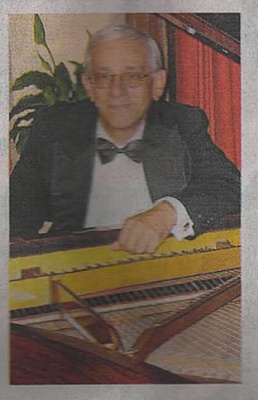
(Photo accompanied obituary notice in The Age)
JOHN Vergona may not have fulfilled his desire to become a priest but he lived his life caring for and supporting some of society's most marginalised, and was one of the bravest men in Australia in the early 1970s when he came out as gay on the front page of The Age at a time when homosexuality was illegal across the country.
Vergona, who has died from motor neurone disease at his home in Hawthorn, aged 65, was born in Moreland to Jack and Ellie Vergona, who lived in West Brunswick at the time.
In 1950, the family, including sisters Mary and Rita and brother Frank, moved to Geelong, where his parents ran a fruit shop.
He encountered a piano for the first time at the home of neighbours, and his parents sent him for lessons, but his teacher soon advised they were wasting their money - not because he wasn't any good but because he played by ear and in his own way. He never learned to read music.
Vergona earned extra income by taking unwanted crates to the local football ground, where he sold them to fans to stand on.
He attended St Roberts Primary School, but in grade 6 was admitted to hospital with a severe bout of asthma. He was later diagnosed with glomerulonephritis, an inflammation of the small blood vessels of the kidneys. The doctor recommended a change of air, so he was sent to board in Wangaratta from 1956 to 1959.
There, he was encouraged by the principal, Brother Bertinus, to practise and perform on piano, to the delight of the brothers and students. He was 11 when a local newspaper advertisement called for a pianist for New Year's Eve at a nearby hotel; he rang and got the job.
The hotel had no idea of his age, so when he arrived they were alarmed to see such a young boy, but by the end of the night he had wowed them all. As well as his fee the patrons passed round a hat and he went home loaded with money.
Sensing early on a calling to the priesthood, Vergona joined and lived with the Oblate order from 1960 to '66, first at Lovely Banks, where he completed his intermediate certificate, and then from 1963 at the seminary at Mulgrave for three years, where he also attended Monash University.
In 1966, after consulting his spiritual adviser, he left the Oblate order and began a series of clerical jobs before becoming the librarian at St Joseph's school in North Fitzroy. He also began supplementing his income by playing piano at various restaurants around town, which he did for 30 years.
In 1972, Vergona somewhat impulsively bought his home in Hawthorn - designed by the same architect responsible for the mansion Labassa in Caulfield. He wrote a cheque for $1000 for the deposit, then spent the weekend trying to raise the money to prevent the cheque from bouncing. He renovated this large house over the years and the garden became a local attraction.
He had also begun voluntary work with Society 5, the first organisation in Victoria to lobby for legislative change for homosexuals. Indeed, he became the first person in Victoria - and only the second in Australia - to publicly declare their homosexuality in the media during a time when acts of love between men were illegal in all states and territories in Australia. He said in the article that he saw his work with Society 5 as helping people, much the same as he would have done had he become a priest.
There was mostly widespread support for Vergona, but also abandonment by some. Bizarrely, the local Italian press wrote an article saying he had defamed Italian manhood (Vergona being an Italian surname) and that there was no such thing as an Italian homosexual.
He also appeared on the then Channel O's Dateline program, where his phone number appeared on screen. There were a few nasty calls but mostly he was inundated with calls from people desperate to talk, with a high proportion from the country. He opened his home for many to visit, most of whom became lifelong friends. Vergona knew he would lose his job at St Joseph's and so resigned to avoid embarrassment to the school. He took to playing piano full-time, seven days a week, and promptly doubled his income. He moved to the Old Melbourne Hotel in January 1973 and continued there for 20 years, a small record in casual music in Melbourne.
In the mid-1980s, at the height of the AIDS epidemic, the Good Shepherd Sisters made available a three-bedroom home in Abbotsford for use by people with HIV/AIDS, a group suffering much hardship and discrimination. This project ''Gunyah'' (Aboriginal for refuge) was enabled by Sister Gretta Noonan, who was much loved by patients at Fairfield Hospital, where Vergona was a volunteer. He, along with Geraldine Kirby and Peter Hayes, extensively renovated the property with the help of volunteers. All his work at Gunyah was voluntary and his involvement lasted 10 years.
Vergona's other work with people with HIV/AIDS continued for many years. While on a cruise, a pastime he embraced in later years, he met a nurse who told him about the people of Palm Island living with HIV. He travelled there on a number of occasions to offer friendship and compassion. He also played music on any old piano; if none was available, he played his piano accordion.
Back in Melbourne, Vergona opened his home to one ill man without any family support, who lived with him until he died. Vergona is survived by his three siblings.
Mark Ellis




